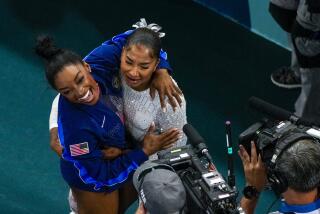Burden Is on Miller : After Her Five Medals at Barcelona Olympics, World Championships Will Provide a Crucial Test
The new world order in gymnastics has arrived and it is propelled by twin engines: the breakup of the former Soviet Union--the sportâs old world order--and the ascension last August of a mite from Edmond, Okla., Shannon Miller.
The political splintering of the once-powerful Eastern Bloc has not diminished the number of elite female gymnasts in the world, but it has left them standing under different flags. While the Unified Team of the former Soviet Union, together for the last time, won the team title at the Barcelona Olympics, gymnasts from other regions shone, too. Miller was one such star.
Only 15 and the smallest member of the entire U.S. Olympic delegation, Miller reaped an unexpected harvest. Her five-medal performance equaled Mary Lou Rettonâs haul of 1984. Factor in that the gymnastics competition at Barcelona featured the worldâs finest sporting nations and the boycotted competition at Los Angeles did not, and Millerâs two silver and three bronze medals was perhaps the best performance ever by an American in her sport.
What remains is for the new order to assert itself. That task will begin Monday at the World Gymnastics Championships at Birmingham, England. Olympic champion Tatiana Gutsu of the Unified Team has retired. Now ranked No. 1 in the world, Miller will be expected to prove the validity of her performance in Barcelona. Were her routines that exceptional and can she repeat them?
Now 16 and reportedly stronger and taller than her 4 feet 6 inches of half a year ago, Miller carries with her to England a burden she did not bear to the Olympics--expectations.
âWe are finding that, for the first time ever, we are going into a major competition not as an underdog,â said Millerâs coach, Steve Nunno.
âShannonâs grasp of gymnastics is unsurpassed in the world. Itâs going to take a while for kids to get to that plateau again. Itâs difficult to keep someone in that shape.â
Which is precisely the point of the changing order after the Olympic Games. Itâs harrowing for a gymnast to train for an Olympic competition. Few are willing or able to start the cycle again. It is a sport from which champions often retire before they are old enough for a driverâs license.
That Miller is back for more is emblematic of the change in the sport. She will not only see new faces, but also deal with new rules calculated to reward difficulty. The International Gymnastics Federation tinkers with its rules after every Olympics, downgrading the worth of tricks that have become pedestrian during the previous four years.
It is an attempt to stay ahead of the athletes. The idea is not to discourage them from rushing to the edge of danger, but to award them fewer points for doing so. When too many perfect scores are given in an international meet, there is sure to be some change.
Miller has changed her routines to reflect this, adding more movement between the high and low bar on the uneven bars, changing her dismount on the balance beam and, in the vault, adding the eventâs most difficult trick--a double twisting Yurchenko.
Millerâs consistency has always been a hallmark of her style, as have precision and grace. Now her routines are loaded with difficulty and, Nunno says, tricks thrown in combinations designed to impress even the most jaded judge.
Millerâs Olympic performance will serve her well at the World Championships, at least with the judges.
Even though no one likes to admit it, gymnastics judging is by definition subjective. Convention holds that judges give the benefit of the doubt to an established world champion or Olympic star. âIn the judgesâ minds, they would like to see the top-ranked athletes win,â Nunno said. âItâs good for the sport. In the minds of the officials and the crowd, a lot of them came to see the No. 1 athlete. They want her to do well. As an athlete, you get that added support. You can feel it, almost like being in front of a home crowd.â
Playing to a crowd has not been Millerâs forte. The shy high school sophomore is trying to project more in her floor exercise routine, to âshare herself with the fans,â as Nunno puts it.
Projection was the strong point of Kim Zmeskal, Millerâs predecessor. Zmeskalâs fizzle at Barcelona begat the next wave of American female gymnasts. Zmeskal is not competing at Birmingham, so joining Miller on the U.S. team this week are Kerri Strug, 15, of Tucson and Dominique Dawes, 16, of Silver Spring, Md. The alternate is Amanda Borden, 15, of Cincinnati.
The menâs team has two UCLA gymnasts--Scott Keswick and Chris Waller--as well as Lance Ringnald of Albuquerque.
It will be the first time that gymnasts from the former Soviet Union will compete for their individual republics. The Unified Team won both the menâs and womenâs competition at Barcelona, so the vacuum is there to be filled.
Nunno is confident in Miller.
âSheâs ready to win the World Championship,â he said. âSheâs focused and confident. This will be the beginning of new things. Itâs going to be a different Shannon Miller, come the next Olympics. She was always the petite, frail, meek gymnast. But now sheâs much stronger. Sheâs got a lot more personality, and sheâs sharing it.â
More to Read
Go beyond the scoreboard
Get the latest on L.A.'s teams in the daily Sports Report newsletter.
You may occasionally receive promotional content from the Los Angeles Times.







